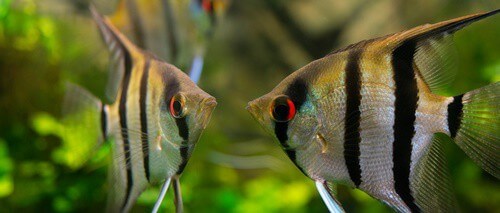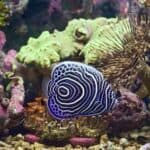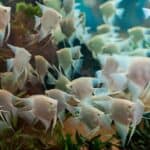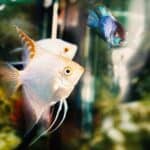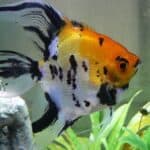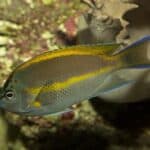Last Updated on: 16th April 2024, 11:07 am
Angelfish aren’t hard to breed, but complications can arise. When stressed by reflections, other tank mates, or water conditions, your angelfish may refuse to produce offspring.
If they’re poorly fed, live in dirty water, or have a tank that’s too small, they may also resist mating.
You need a spacious and secure tank environment, quality food, and hiding places to encourage angelfish to breed. You must maintain the water’s pH balance, hardness, and temperature.
You can provide bulky decorations or tall plants to create nests around or use a spawning plate.
The best approach to breeding angelfish is to get several juveniles or an established breeding pair. Juveniles will breed longer, and a batch of 4-6 allows them to pick their mates.
An established pair will be cheaper, but breeding could have average results if they’re old or unhealthy.
When Are Angelfish Ready To Breed?
The average breeding age for angelfish is between 6 to 12 months.
This is when they reach sexual maturity and begin pairing off with mates. At this age, angelfish can grow between 6 and 10 inches in length.
Once they’ve reached their breeding age, they can continue reproducing for most of their lives.
As they age, their offspring may see a decline in health and an uptick in defects. That makes it wise to get a young breeding pair if you can.
How Old Do Angelfish Have To Be To Breed?
Angelfish start to breed at different ages, depending on their species and health.
Some will require a full 12 months to reach sexual maturity. Others will only need 6 months to develop to their full size and produce eggs or sperm.
To ensure the angelfish are ready to breed sooner, be sure to provide them with:
- A clean environment.
- Ample tank space.
- Medium exposure to light.
- A balanced diet.
The less their body struggles to grow, the sooner the fish reaches its reproductive phase.
How Big Do Angelfish Have To Be To Breed?
Angelfish won’t mature until they’ve gained most of their adult size.
Depending on the species, this may sit between:
- 4 inches, in the case of dwarf angelfish.
- 6 inches, in the case of most angelfish breeds.
- 10 inches for large saltwater angelfish.
Size may not be an accurate way to gauge your angelfish’s readiness to breed. A fish’s growth may have been stunted in its youth, halting its size and length.
Pay attention to the age, behavior, and breeding cycle to determine when to expect eggs.
Angelfish Breeding Behavior
You can tell that a female and a male have paired off when they swim exclusively together. They’ll avoid grouping with other fish and may even attack other fish that get too close.
This pairing-off can help you differentiate between juvenile and breeder pairs. Unpaired angelfish usually cower away from breeder pairs, as aggression can increase once a pair has formed.
Several other physical and behavioral characteristics indicate their readiness to breed. These include:
- The breeding pair will isolate themselves.
- They show aggression toward others outside of their chosen partner, like pecking or nipping.
- They’ll clean different areas of the tank and test for a nest site.
- They’ll increase territorial behavior, such as fin flicking, flaring gills, and attacking other fish.
- Their colors will become more vibrant or intense.
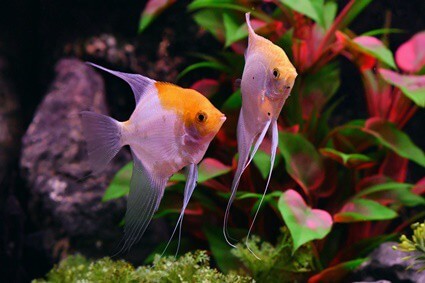
Angelfish Breeding Cycle
The reproductive cycle of angelfish follows a unique pattern.
About 2 to 3 days before they spawn, female angelfish expose their ovipositor. This is a small, tubular genital structure that is responsible for depositing their eggs.
Male angelfish, on the other hand, don’t expose their genitalia. They only do so at the exact moment before breeding happens.
As the spawning time nears, the female will be seen cleaning out the nesting area more frequently.
Males may also be observed cleaning leaves or rocks. However, they don’t show strong preferences for what they clean. Likewise, they don’t perform this behavior to the extent that females do.
Furthermore, males and females will become increasingly defensive of their nesting area. This is seen in threatening displays, chasing, and biting other angelfish if they get too close.
Once the female angelfish has settled on her chosen nest site, she will skim the surface with her ovipositor before releasing her eggs. Males will then fertilize the eggs after they have been laid.
How Long Does It Take For Angelfish To Breed?
Angelfish pairs can spawn every 7 to 10 days if the eggs are removed. You would only do this if you want your breeding pair to produce eggs faster.
Angelfish will not lay a new nest of eggs if they can access their previous clutch. If you leave the eggs until hatching, a new spawn will be produced once the fry has become juvenile.
How long it takes for angelfish to breed depends on your definition of breeding. Does this mean from fertilization to egg hatching? Or does this include the pre-fertilization of eggs?
If you understand their breeding cycle, you can determine how long it takes by observing the behaviors:
- Egg laying and fertilization occur in a matter of 3-6 hours.
- 48 to 60 hours after the spawn, these eggs hatch into wrigglers.
How To Tell If Angelfish Eggs Are Fertilized
Fertilized and healthy eggs have a translucent, amber, or brownish color. White and opaque eggs, while they may not be dead, are unhealthy and have low chances of hatching.
If your white eggs are also fuzzy, this indicates they have a fungal infection. Unfortunately, this means the eggs are dead or will die shortly.
Do Angelfish Breed Easily?
Angelfish doesn’t require special tank setups, privacy screens, or certain temperatures to reproduce. However, they may refuse to breed if they’re:
- Overcrowded in a too-small tank.
- Live in dirty water.
- Short of hiding spots to create nests.
- Are too stressed by other fish.
- Are underfed.
Because of this, you might struggle to make your angelfish mate and produce offspring. Creating a healthy, spacious environment is the key to making angelfish easy to breed.
Will Angelfish Breed in a Community Tank?
Angelfish can breed in community tanks. While it is safer and easier to breed fish in a secluded tank, just for the parents and fry, this isn’t necessary. Angelfish can safely raise their fry in a tank if:
- The tank is spacious enough.
- The tank has sufficient decorations and hiding places.
- The tank isn’t full of aggressive tank mates, which might irritate the parents.
Even in an ideal tank, the parents may become aggravated by other fish and start fights. If overly stressed, the parents may even eat their fry. Other fish may also snack on the eggs opportunistically.
To prevent this from happening, you can take precautions:
Give The Parents A Hiding Place
Angelfish parents will naturally lay their eggs in a secluded area of the tank, away from other fish. You should provide them with plants, decorations, or a spawning plate for them to do so.
Tall and somewhat compact plants work well. You can match this with bulky decorations that limit how many fish can access the space.
Without these safeguards, the angelfish may become aggressive or so stressed that they refuse to spawn. If your healthy breeding pair refuses to lay eggs after several weeks, consider rearranging your tank or providing them with a breeding aquarium.
Schedule Feeding Times
When your angelfish are breeding, make sure to feed all of your fish more often.
Not only will this ensure that the parents can produce healthier offspring. It will also make larger or more aggressive fish less hungry, so they’re less willing to start fights over the eggs.
Pick Good Tank Mates
Of course, picking docile tank mates for your angelfish is recommended. This will make breeding, raising fry, and everyday life easier for your angelfish. Here are suitable tank mates to choose from:
- Tetras.
- Rasboras.
- Dwarf Gouramis.
- Rainbowfish.
- Corydoras.
- Small catfishes (Plecos, Pictus).
- Zebra Loaches.
- Platies.
- Mollies.
- Rainbow Kribs.
- Cichlids (Discus, Zebra, Dwarf).
How Do I Get My Angelfish to Breed?
If your angelfish aren’t breeding independently, there are ways to encourage them to reproduce.
You’ll need to consider two factors:
- The right tank and environment setup.
- The proper diet and feeding.
Setting Up A Breeding Tank for Angelfish
To make your angelfish breed, you must offer them a well-maintained tank.
Fish that are uncomfortable or unsafe in their environment will ignore their breeding instincts. The hormones that encourage mating will sometimes discontinue altogether.
In dirty, cramped, or poorly balanced tanks, angelfish will refuse to produce sperm and eggs or pair off with one another. Their bodies view the tank as unsafe for adults but especially harmful for offspring.
Tank Water
Your tank water should be within an angelfish’s ideal parameters.
These ranges will increase the chances of your angelfish breeding:
| pH | 4.7 to 8.7 (but 6 to 8 recommended) |
| Hardness | 3° to 8° dKH |
| Temperature | 72 to 82 degrees Fahrenheit or 22.2 to 27.8 degrees Celsius |
| Water Flow | Low/Gentle |
Water pH
The pH refers specifically to two ions: ammonia and ammonium. Lower pH levels mean higher ammonium concentrations. In contrast, high pH levels refer to higher ammonia concentrations.
Maintaining pH levels is vital for your angelfish since this affects their ability to regulate sodium influx and efflux in their bodies.
Sodium works to balance an angelfish’s body fluids. That improves the growth and survival of both your angelfish and their eggs.
According to the International Journal of Tropical Biology and Conservation, wild angelfish prefer a pH lower than 7. Overall, they can healthily survive in pH levels around 6 to 8.
Water Hardness
Water hardness is a term used to define the amount of dissolved minerals within the water.
Of course, hard water has a greater amount of such minerals. KH is one measurement of water hardness used to decide how much carbonate is in the water.
KH is vital for your tank because it buffers the acids naturally produced from your angelfish’s feces. Therefore, it stops the water pH from changing suddenly.
Maintaining KH levels goes hand in hand with maintaining pH levels.
Water Temperature
The temperature of your water directly affects the lifestyle of your angelfish.
Too low temperatures will decrease their willingness to eat and their spawning frequency. Overly high temperatures can enhance bacteria growth and prematurely age your fish.
Tank Size
Angelfish pairs tend to do well in taller aquariums that are at least 12 inches in depth. It is not uncommon for these species to grow to large sizes when given enough space. The more room your breeding pairs have, the more likely they are to produce healthy spawn.
As for volume, it is recommended that you fill your angelfish tank with at least 20 gallons. Remember that these are the minimum requirements for 1-2 angelfish. You should adjust these measurements if you plan on having more than one breeding pair.
Tank Decorations
Providing an environment mimicking the angelfish’s natural habitat is crucial for successful breeding. In the wild, angelfish quickly hide in plant life and around coral.
You can offer such areas by placing tall or broadleaf plants and roots within your tank. For substrate, gravel is not recommended. Use potted plants and driftwood instead.
Tank Filter
You will need a filter to remove dangerous toxins and particles from your tank. While the machine does so, it must also be slow-moving and avoid stirring up the water. Angelfish do best in gentle currents, and their eggs can get swept up.
Sponge filters are a great option. They keep the water clear, lessen the turbulence in your water flow, are easy to clean, and can be used repeatedly.
Diet and Feeding
Angelfish that are well-fed will produce healthier fry and more resilient eggs. To encourage your fish to breed successfully, broaden their diet. Angelfish are omnivores, so they require:
- Flake or pellet fish food.
- Chopped veggies, such as cucumber or peas.
- Dried or live bloodworms.
- Brine shrimp.
- Mysis shrimp.
Ensure you remove any uneaten food 3 to 5 minutes after feeding them.
You should always feed adults 2-3 times a day. You should also rotate the daily diet. If you’ve provided them with brine shrimp one day, try chopped veggies the next.
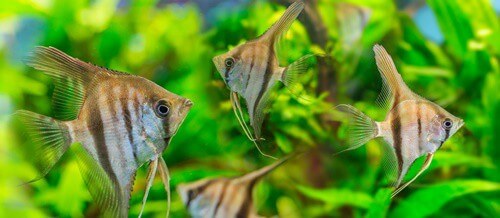
Angelfish Breeding Tips
Now that you have the ideal conditions, it’s time to start breeding. Here are some tips that will help your angelfish reproduce successfully.
Selecting A Breeding Pair
Breeding angelfish isn’t as simple as housing a female and male together and expecting endless fry. Two angelfish may click instantly, while others will dislike the sight of each other. To create a viable breeding pair, you can:
- Get angelfish that have already mated.
- Get several juvenile angelfish (of both sexes) and have them naturally pair off.
The first option can save you time and hassle. When you buy an existing pair, make sure to ask about:
- Their age
- The success of their spawns
While vendors may advertise them as a breeding pair, you won’t get many viable eggs if they are too old. Additionally, they may not produce quality offspring if they haven’t been well-fed and cared for.
Getting several juvenile angelfish may cost significantly more than simply buying a breeding pair. However, there are advantages.
You are guaranteed to have multiple spawning years when you get angelfish as a juvenile. You will also get more than one breeding pair because they can choose their mates without pressure.
This will make it easier to breed throughout the coming years.
Use A Spawning Slate
While most angelfish will choose a flat, clean surface to lay eggs on, you can also provide a spawning slate. This has many advantages.
- Slates offer a better surface to which eggs can attach.
- Spawning slates allow for water and airflow toward the eggs, improving their chances of hatching.
- Slates are easier to move, which is helpful if you need to remove any infertile or fungi-infected eggs.
- You always know where the eggs are so you can monitor them.
Angelfish are picky about their nests. For this reason, buying at least 2 spawning slates is recommended.
This gives your angelfish options to pick from. It also increases their chances of laying the eggs on the slates rather than on a decorative plant or piece of driftwood.
Spawning slates are not strictly necessary. However, porous material like driftwood encourages bacterial and fungal growth. This could leave your angelfish’s eggs vulnerable to infection and death.
Once a breeding pair has spawned on the slate, they will likely do so again.
Tank Floor
Angelfish may get stressed by their reflection.
Paint the bottom of the tank a dark color, but only on the outside. This will keep the fish from catching sight of supposed predators lurking down below.
Depending on the angelfish, painting only the bottom may not be enough. You might have to cover the entire tank with a cloth or switch off any lights nearby.
Other angelfish do not require such extensive measures. You must observe the fish and see what improves their comfort levels.
Change Tank Water Frequently
Changing your tank water frequently removes waste, toxins, and bacteria that accumulate over time. This keeps the water quality high and the tank clearer. Both of these factors are directly linked to your angelfish’s health.
Angelfish thrive in tanks with water changed by 40% or more over a week. Consequently, you should change your water often and in increments of 5%-15% each time.
It is unlikely that angelfish pairs will breed if 40% or less of their water is unchanged each week. Angelfish are not difficult to breed. They will reproduce as long as you create a safe, calm environment for them.

